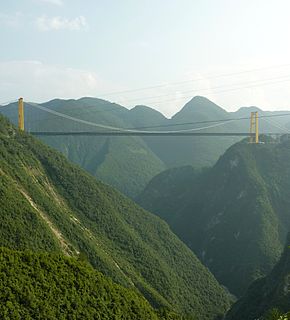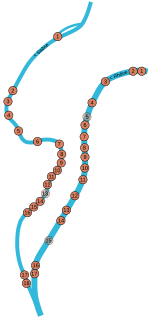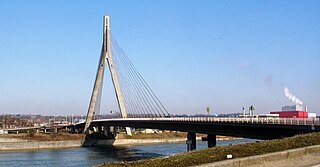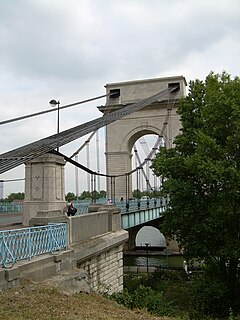Joseph Chaley (1795 – April 15, 1861) was a French civil engineer and a pioneer designer of suspension bridges in the 19th century. He was a medical officer in the army before becoming a bridge designer.

France, officially the French Republic, is a country whose territory consists of metropolitan France in Western Europe and several overseas regions and territories. The metropolitan area of France extends from the Mediterranean Sea to the English Channel and the North Sea, and from the Rhine to the Atlantic Ocean. It is bordered by Belgium, Luxembourg and Germany to the northeast, Switzerland and Italy to the east, and Andorra and Spain to the south. The overseas territories include French Guiana in South America and several islands in the Atlantic, Pacific and Indian oceans. The country's 18 integral regions span a combined area of 643,801 square kilometres (248,573 sq mi) and a total population of 67.3 million. France, a sovereign state, is a unitary semi-presidential republic with its capital in Paris, the country's largest city and main cultural and commercial centre. Other major urban areas include Lyon, Marseille, Toulouse, Bordeaux, Lille and Nice.

A civil engineer is a person who practices civil engineering – the application of planning, designing, constructing, maintaining, and operating infrastructures while protecting the public and environmental health, as well as improving existing infrastructures that have been neglected.

A suspension bridge is a type of bridge in which the deck is hung below suspension cables on vertical suspenders. The first modern examples of this type of bridge were built in the early 1800s. Simple suspension bridges, which lack vertical suspenders, have a long history in many mountainous parts of the world.
Chaley pioneered the construction of suspension bridge cables by bringing together individual wire strands in mid-air, a technique later known as aerial spinning. Previously, the entire cable had been bound together before lifting into place, but Chaley's system, inspired by the ideas of Louis Vicat, allowed considerably longer cables to be erected at less cost. [1]
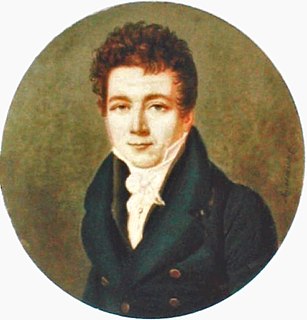
Louis Vicat French engineer.
He built the Grand Pont Suspendu at Fribourg in 1834, a world record-breaking span of 273m, only overtaken 16 years later by Charles Ellet Jr.'s 308m span Wheeling Suspension Bridge. Chaley had previously worked with Marc Seguin's brother Jules on the Tarascon-Beaucaire Bridge (1828) and also the Chazey-sur-Ain Bridge (1829). [1]

Fribourg or Freiburg is the capital of the Swiss canton of Fribourg and the district La Sarine. It is located on both sides of the river Saane/Sarine, on the Swiss Plateau, and is a major economic, administrative and educational center on the cultural border between German and French Switzerland (Romandy). Its Old City, one of the best-maintained in Switzerland, sits on a small rocky hill above the valley of the Sarine.

Charles Ellet Jr. was an American civil engineer who designed and constructed major canals, bridges, river improvements and railroads before the American Civil War. He also advocated using steam-powered vessels in naval warfare, volunteered to serve in the U. S. Army Corps of Engineers, received a commission as colonel and became the only casualty during the Union naval victory at the Battle of Memphis.

The Wheeling Suspension Bridge is a suspension bridge spanning the main channel of the Ohio River at Wheeling, West Virginia. It was the largest suspension bridge in the world from 1849 until 1851. Charles Ellet Jr. designed it and supervised construction of what became the first bridge to span a major river west of the Appalachian mountains. It linked the eastern and western section of the National Road, and became especially strategically important during the American Civil War. Litigation in the United States Supreme Court concerning its obstruction of the new high steamboat smokestacks eventually cleared the way for other bridges, especially needed by expanding railroads. Because this bridge was designed during the horse-and-buggy era, 2-ton weight limits and vehicle separation requirements now apply.
Chaley first presented a proposal for the Grand Pont Suspendu in February 1830, and was awarded the contract in June of that year. His estimated cost of less than 300,000 florins was well below other competitors, including Guillaume Henri Dufour. Chaley's bridge was supported on four main cables (two per side), each consisting of 1056 wires each 3.08mm in diameter. It carried 2000 people on its opening day. It was replaced in 1923 by a reinforced concrete arch bridge. [1]

Guillaume Henri Dufour was a Swiss army officer, bridge engineer and topographer. He served under Napoleon I and held the office of General four times in career, with the first being in 1847 when he led the Swiss forces to victory against the Sonderbund. Dufour presided over the First Geneva Convention which established the International Red Cross. He was founder and president of the Swiss Federal Office of Topography from 1838 to 1865.

A wire is a single, usually cylindrical, flexible strand or rod of metal. Wires are used to bear mechanical loads or electricity and telecommunications signals. Wire is commonly formed by drawing the metal through a hole in a die or draw plate. Wire gauges come in various standard sizes, as expressed in terms of a gauge number. The term wire is also used more loosely to refer to a bundle of such strands, as in "multistranded wire", which is more correctly termed a wire rope in mechanics, or a cable in electricity.

Reinforced concrete (RC) (also called reinforced cement concrete or RCC) is a composite material in which concrete's relatively low tensile strength and ductility are counteracted by the inclusion of reinforcement having higher tensile strength or ductility. The reinforcement is usually, though not necessarily, steel reinforcing bars (rebar) and is usually embedded passively in the concrete before the concrete sets. Reinforcing schemes are generally designed to resist tensile stresses in particular regions of the concrete that might cause unacceptable cracking and/or structural failure. Modern reinforced concrete can contain varied reinforcing materials made of steel, polymers or alternate composite material in conjunction with rebar or not. Reinforced concrete may also be permanently stressed, so as to improve the behaviour of the final structure under working loads. In the United States, the most common methods of doing this are known as pre-tensioning and post-tensioning.
Chaley's other suspension bridges include the 227m Pont du Gottéron (1840); and a 64m span at Collomby in Valais (1840). He collaborated with Bordillon on the Basse-Chaîne Bridge at Angers, completed in 1839. This bridge collapsed in 1850 killing 226 soldiers, a major setback to suspension bridge construction in France and beyond. [1]

Angers is a city in western France, about 300 km (190 mi) southwest of Paris. It is chef-lieu of the Maine-et-Loire department and was the capital of the province of Anjou until the French Revolution. The inhabitants of both the city and the province are called Angevins. Not including the metropolitan area, Angers is the third most populous commune in northwestern France after Nantes and Rennes and the 17th in France.
His only bridge still in existence is the 121m suspension bridge at Corbières (1837). [1]

Corbières is a municipality in the district of Gruyère in the canton of Fribourg in Switzerland. On 1 January 2011 the former municipality of Villarvolard merged into the municipality of Corbières.







